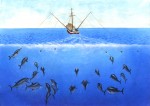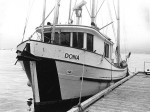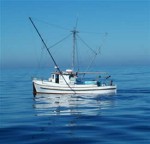One of the events we looked forward to every year was the return of the trollers1 in the Spring to McInnes Island waters. Around the station was troller territory. In the deeper waters of Milbanke Sound was the place for the seiners.
 We made friends with a few of the fishermen, and always got a wave from all the boats when we were on the water. Sometimes we also got advice on what to use (lures or bait) and how deep. They knew we were not much competition.
We made friends with a few of the fishermen, and always got a wave from all the boats when we were on the water. Sometimes we also got advice on what to use (lures or bait) and how deep. They knew we were not much competition.
Trolling looks like a very leisurely activity, and it usually is in a sport boat with only one or two lines in the water. On a commercial troller boat with fifty (50) lines in the water it was hectic. It was an all day job, from first light to dusk. Sometimes alone, sometimes with two men, depending on the size of the boat.

One of the trollers we got to know very well was the fishing vessel (FV) Lyndona, owned and run by Bruce Arundel. It was a beautiful wooden boat, built in 1965 in a Prince Rupert boatyard. The boat was still registered to Bruce’s son Danny in 2006 in Gibsons, BC. After that there is nothing on it.
I spent many hours riding with Bruce on the boat. I used to come alongside between the downrigger wires, Bruce would grab my bowline and I would hop aboard. Then he would tie my boat out the back of the Lyndona between all the lines. I saw some big salmon come into that boat at times. Made me envious, as sometimes I had been trolling for a few hours and not even a nibble.
Trolling for salmon is one of the best and least wasteful ways of commercial fishing. The product arrives as fresh as the day it left the ocean. The fish is landed, and if time permits, gutted, bled and flash frozen in a few minutes. These men worked fast. First to preserve the fish, and second to keep the fish coming into the boat if the bite was on (the fish were biting).
Out to the west of McInnes Island was a large reef, well-marked on the charts. The local fishermen knew to stay away from it as it shallowed very quickly, but every once in a while we would hear a boat motor roar quickly into life as a newcomer found the reef with his cannonballs. (lead balls used to carry the lines deep).
Bruce said there must be a fortune in lead cannonballs on that reef. Many years later a boat with divers did park there for awhile and took many away.
 We used to like the trollers as they were clean boats, both in appearance and in fishing methods. Sometimes if our garden produced a lot we would take the extra produce out to the boats, and were rewarded with a fish for supper in exchange. That worked well for us, and them, as they were sometimes out for weeks and fresh stuff ran low.
We used to like the trollers as they were clean boats, both in appearance and in fishing methods. Sometimes if our garden produced a lot we would take the extra produce out to the boats, and were rewarded with a fish for supper in exchange. That worked well for us, and them, as they were sometimes out for weeks and fresh stuff ran low.
I really do miss seeing the trollers working.
If anyone knows the whereabouts of the Lyndona, please drop me a line – contact.
More information on commercial fishing on the Canadian government website.
FOOTNOTES:
1trolling – Trolling is a method of fishing where one or more fishing lines, baited with lures or bait fish, are drawn through the water. This may be behind a moving boat, or by slowly winding the line in when fishing from a static position, or even sweeping the line from side-to-side, e.g. when fishing from a jetty. – more in Wikipedia